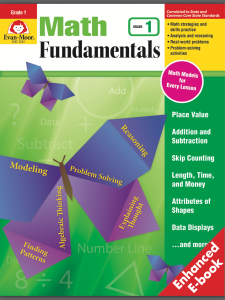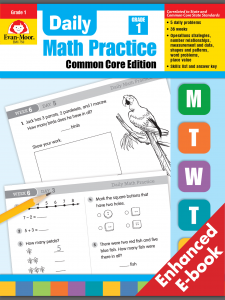This post may contain affiliate links. Affiliate links use cookies to track clicks and qualifying purchases for earnings. Please read my Disclosure Policy, Terms of Service, and Privacy policy for specific details.
If your child is behind in math, you may need a way to catch your child up to grade level. The pacing of Evan-Moor’s math curriculum is easily adjusted to accommodate a child’s learning needs. This article explains the process of using Evan-Moor math to catch your child up to grade level and includes recommendations for special needs children. The same methods can also be used to accelerate a gifted or otherwise advanced learner.
Steps to Catch Your Child Up to Grade Level Using Evan-Moor Math
Step 1: Get the Evan-Moor Math Curriculum
The first step is to buy the Evan-Moor math curriculum for the grade levels you need for the current school year. If you need to catch a child up, buy the grade level you need for their current skill level and additional books for their target grade level. I would only recommend attempting to teach 2 years worth of content in one school year. Depending on how far the child is behind and their learning needs, you may need more than one school year to catch your child up to grade level.
For each grade level you need, buy the Math Fundamentals book and the Daily Math Practice book. Both print versions and e-versions are available to buy separately. You can also get printed versions in a special homeschool bundle priced with an everyday discount of 25%. CLICK HERE to learn more about Evan-Moor’s special homeschool bundles.
Step 2: Determine the Reason(s) Your Child is Behind
There are a few reasons you may need to get your child caught up to grade level. The way you approach catching up, will depend on the reason for the delay.
Poor Curriculum
Some homeschool math curriculum just does not align with grade level standards. You may think your child is doing well in math, than an assessment shows that they are behind. If this is the case, you will need to find the gaps in instruction and teach the missing skills. To find the gaps in instruction, CLICK HERE to follow the procedure I used to start using Evan-Moor mid-year. Then come back and read the rest of the information in this article.
Insufficient Teaching
Whether your child is home taught or goes to public school, they may not click with the instructional style presented in their previous math curriculum. If this is the case, you will need to go back and re-teach the material. The Evan-Moor Math Fundamentals books present math concepts clearly.
Learning Disability
If your child has a learning disability (diagnosed or not) that affects their ability to calculate or memorize math facts, they are likely behind grade level in math. In order to compensate for the math related learning disability, add in manipulatives to your teaching and allow the use of a calculator or math facts cheat sheet (e.g., a multiplication chart).
CLICK HERE to read about my recommendations on when to use a calculator accommodation.
CLICK HERE to read my recommendations on must-have math manipulatives for grades K-3..
CLICK HERE to read about how I added manipulative into a 2nd grade Math Fundamentals lesson on place value.
CLICK HERE to read about how to help children who struggle with math facts.
Intellectual Disability
If your child is behind in math due to an intellectual disability, you may not be able to catch them up to grade level. Children with an intellectual disability take longer to learn content. Evan-Moor math may still work well for them, but you may need to slow the pacing down.
Step 3: Calculate Learning Schedule for Catch Up
Each grade level for Evan-Moor math includes approximately 36 weeks of daily content. If you need your child to catch up one grade level, have them complete 2 days worth of work from the Daily Math Practice series and 2-4 pages per day in their Math Fundamentals book. Completing twice the amount of work should not be overwhelming for most children. Doubling the content in the Daily Math Practice book would be a total of 10 practice problems per day, which is less than the daily problems required in other math curricula.
If you homeschool year round, you can calculate your catch up schedule based on how many days you do homeschool per year. Also, if you do a 4-day school week, adjust your catch-up schedule accordingly.
To calculate your pacing schedule, take the total number of pages you need to cover and divide that by the number of days you plan on doing school during the year.
If the child is multiple years behind grade level, I would recommend taking more than one year to catch your child up to grade level. Also, depending on the child’s learning needs, you may need to slow the pacing down. For example, you may want to try to complete 1.5 years of math content instead of attempting 2 years of content in one school year.
Accommodating Learning Needs
Although you have an intended schedule for catching your child up to grade level, you still need to be flexible in order to ensure content mastery. For example, if your child is having difficulty grasping content covered in math fundamentals, you may need to take an extra day or two. You may also need to add in mainpulatives to teach the problem concept. If you know your child has previously covered and mastered a unit in their previous math curriculum, it is perfectly okay to skip over that same content when working to catch your child up to grade level.
Accommodating Children with Attention Difficulties
Children who struggle with math may have difficulty focusing on problems or completing more work. In order to catch them up to grade level, follow the schedule needed to catch up, but include breaks between activities/completed pages as needed. Breaks could include a snack, exercise, a game, or something else that would be fun for the child.
CLICK HERE to read my article about research based adaptations to help a child with ADHD or an otherwise very active child.
Step 4: Prepare Materials and Get Started
Now that you have your pacing schedule calculated to catch your child up to grade level, you are ready to get started. Evan-Moor math is an open-and-go curriculum and requires minimal preparation time. Pull out your books and get started. If you have the e-versions, print out what you need for the week.
Step 5: Monitor Progress
The Daily Math Practice activities provide just the right amount of problems for review and skill mastery. You can also use the results as an informal assessment to determine if any specific skills need to be re-taught. If a child misses a problem, you can quickly review how to calculate the problem correctly. If the child consistently misses that type of problem, you will need to go back to the Math Fundamentals book and reteach the content.
Summary on How to Use Evan-Moor Math to Catch Your Child up to Grade Level
Evan-Moor Math is a high quality curriculum that can be used to catch your child up to grade level math. Buy the curriculum and plan your pacing schedule. Start using the curriculum and make accommodations based your child’s learning needs.
Homeschool bundle up to $160 OFF! Saving you money on resources and time on lesson prep!




What an excellent method to help kids get caught up OR to work ahead in math! I really appreciated these helpful steps. I know many homeschooling families will appreciate what a clear plan you have shared. 🙂